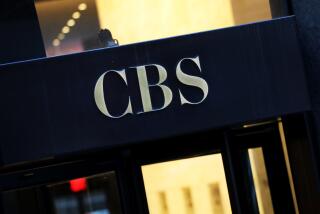Court Voids FCC Ban on Indecent Programming
- Share via
WASHINGTON — A government ban on broadcasting “indecent” material between the hours of 6 a.m. and midnight was struck down Tuesday by a federal appeals court here, which held the prohibition to be so broad that it violated the First Amendment’s free-speech guarantee.
The ruling marks the third time in five years that the court has thrown out government attempts to limit indecent broadcasts. It is certain to deepen confusion over the already murky issue of radio and television obscenity and efforts to restrict such broadcast personalities as controversial radio “shock jock” Howard Stern.
While recognizing that a compelling interest exists in protecting children from broadcast material, the U.S. Court of Appeals for the District of Columbia said that Congress and the Federal Communications Commission failed to demonstrate that the 6 a.m.-to-midnight schedule was “the least restrictive means” of doing so.
“The government did not properly weigh viewers’ and listeners’ First Amendment rights when balancing the competing interests in determining the widest safe harbor period consistent with the protection of children,” the court said in its 3-0 ruling.
The court, however, did not quarrel with the FCC’s definition of “indecent” material.
FCC rules, adopted following congressional action in 1992, define indecency as “language or material that, in context, depicts or describes, in terms patently offensive as measured by contemporary community standards for the broadcast medium, sexual or excretory activities or organs.” Timothy K. Dyk, who argued for the challengers in the case, and other broadcast industry lawyers hailed the court’s action. They said it established that any regulation must be “very limited” in scope.
Although the case did not directly involve Stern, Dyk said that the ruling raises a “serious question” about the validity of more than $1 million in fines the FCC has levied against stations that carry Stern’s show. Until the FCC issues new regulations, “it’s not at all clear that they can sustain those fines,” Dyk said.
It could not be determined Tuesday whether the FCC will appeal the ruling to the Supreme Court. The Court of Appeals here handles all challenges of actions by federal regulatory agencies and its rulings set standards for the nation unless they are overturned by the Supreme Court.
In a separate decision, the appeals court also held that the government cannot grant cable television operators the authority to reject indecent programming on so-called access channels--those set aside for public, educational or governmental use.
In addition, the court sent back for reconsideration by the FCC a congressionally mandated rule requiring cable operators to place indecent material on separate channels accessible only by subscribers who submit written requests.
The ruling, by Judge Patricia Wald, Chief Judge Abner Mikva and Judge Harry Edwards, marks the third time that the court has struck down FCC rules restricting the broadcasting of “indecent” material.
In 1988, the court upheld the FCC’s indecency standard but struck down a time restriction on such material that was similar to the one voided by the court Tuesday. In that instance, FCC regulations had granted a “safe harbor” for broadcasting indecent material that ran from midnight to 6 a.m.
Congress reacted by directing the FCC to issue regulations for enforcing the indecency ban on a 24-hour basis. The court, however, struck down that total ban, holding that indecent material must be allowed to be broadcast at some time and that even “Congress itself” could not totally ban indecent speech.
Congress stepped in again with the Public Telecommunications Act of 1992, which required the commission to bar the broadcast of indecent material from 6 a.m. to midnight. Lawmakers presumably believed that if Congress established the time restrictions, rather than leaving them to FCC rulemaking, the limitation would have more weight with the courts.
The FCC’s regulations stemming from that act, and voided by the court Tuesday, also allowed public stations that go off the air at midnight to broadcast the material from 10 p.m. to midnight.
In justifying its 6 a.m.-to-midnight ban, the FCC cited three goals: ensuring that parents have an opportunity to supervise their children’s radio listening and TV viewing; “ensuring the well-being of minors,” regardless of parental supervision, and protecting “the right of all members of the public to be free of indecent material in the privacy of their homes.”
The court rejected the general public protection as “insufficient to support a restriction on the broadcasting of constitutionally protected ‘indecent’ material.”
As for protecting children, “we are at a loss to detect any reasoned analysis supporting the particular safe harbor mandated by Congress,” the court said.
Lynn McReynolds of the National Assn. of Broadcasters said that the law as written “infringes on broadcasters’ First Amendment rights and makes for a chilling effect on programming. Every time Congress passes something like this, the court has stayed the rules, so we’re pleased with the ruling, but not surprised.”
Times staff writer Amy Harmon in Los Angeles contributed to this story.
More to Read
The biggest entertainment stories
Get our big stories about Hollywood, film, television, music, arts, culture and more right in your inbox as soon as they publish.
You may occasionally receive promotional content from the Los Angeles Times.










